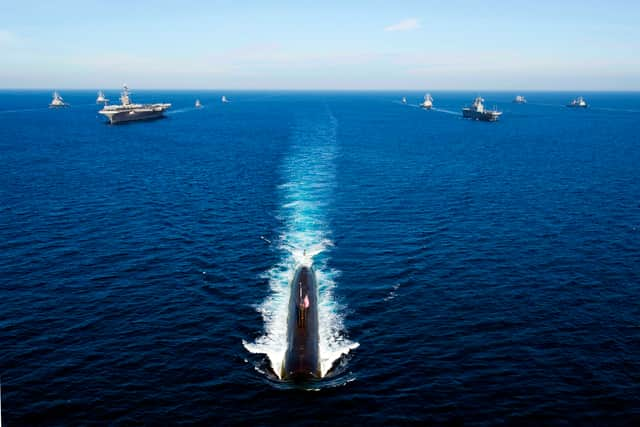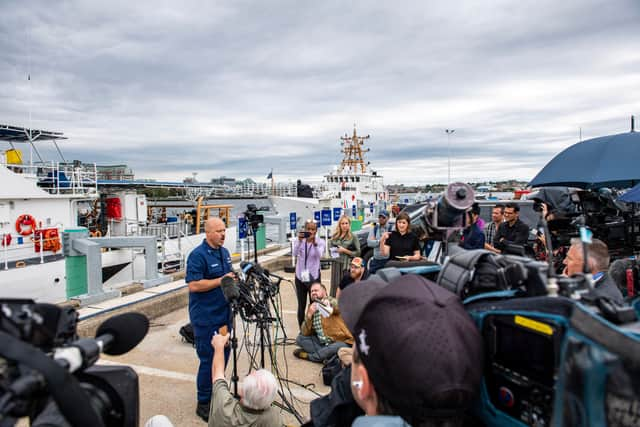How deep can a submarine go? Maximum diving depth of subs as debris from the Titan was found
and live on Freeview channel 276
The Titan submersible, which went missing on Sunday, is believed to be somewhere near the wreck of the Titanic, 3,800 metres below the ocean’s surface, 370 miles off the coast of Newfoundland. The US Navy has said it detected a sound consistent with an implosion near where the submersible lost communication and a remotely operated vehicle had discovered the nose cone of the Titan around 487m from the bow of the Titanic.
The passengers who died in the implosion of the Titan, which was bolted from the outside, are OceanGate CEO Stockton Rush, British businessman Hamish Harding, French Titanic expert Paul-Henri Nargeolet, British-Pakistani businessman Shahzada Dawood, 48, and his son, Suleman, who is 19.
Advertisement
Hide AdAdvertisement
Hide AdIt was estimated that when the submersible lost contact with the surface on Sunday, those inside had around 96 hours of reserve oxygen which will run out at around 8am on Thursday 22 June BST. A major obstacle involved in the search was the depth at which Titan is likely to have travelled to - at a depth of more than 3,000m, visibility will be virtually zero without external artificial light sources, and water pressure will be immense.
How deep can submarines go?
Free divers at low depths risk suffocation or crushed lungs from the pressure - which submarines are designed to protect passengers from. Submarines can generally dive to a depth of around 300m - for context, the deepest part of the Pacific Ocean, the Mariana Trench, is 11,000m deep.


US Los Angeles-class submarines have a test depth of around 450m, but their maximum dive depth is believed to be around 675–900m. Test depths, are the depths that a submarine can travel to under normal peacetime conditions.
Some Russian submarines are believed to reach maximum depths of up to 2,000m. The biggest challenge that submarines face is the water pressures - every 10m of depth adds one atmosphere of pressure - so at 300m, submarines operate under 30 atmospheres of pressure, at this depth a diver outside a submarine would start to feel effects such as impaired brain function.
Advertisement
Hide AdAdvertisement
Hide AdThe true depths that the best military grade submarines can travel to is likely unknown in order to protect military secrets.
The Titan submersible vessel is designed to travel to depths of 3,800m, to where the wreck of the Titanic rests at the bottom of the North Atlantic Ocean. This is almost twice the depth that the best submarines are capable of travelling to.


Why can submersibles dive deeper than submarines?
A submersible has limited power and must be deployed and retrieved by a mothership, as was the case with the Titan submersible.
Submersibles are constructed with different aims to submarines - they are designed to reach very low depths whereas military submarines must also accommodate the stress of combat.
Advertisement
Hide AdAdvertisement
Hide AdThe Challenger Deep, the deepest known point of the Earth’s seabed, was reached by Jacques Piccard in the submersible Trieste, at a depth of 10,971m, where the pressure is more than 1,000 bars.
What vehicles are being used to find the Titan submersible?
The search for the Titan submersible continues today (21 June) as the air supply is believed to be running low for those inside the lost vessel. US and Canadian authorities, as well as private deep sea exploration companies are involved in the search and rescue mission which is being run from Boston.
The search was relocated when noises were heard near the area where the Titan went missing, and several cutting edge technologies are being used in the attempt to locate it.
A Canadian P-3 plane using sonar buoys picked up on the sounds which were believed to be banging noises heard at 30 minute intervals. Remote operated vehicles have also been used to explore underwater. A Royal Canadian Navy ship which is equipped with a decompression chamber has also been deployed.
Comment Guidelines
National World encourages reader discussion on our stories. User feedback, insights and back-and-forth exchanges add a rich layer of context to reporting. Please review our Community Guidelines before commenting.
